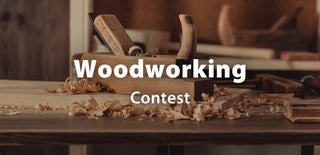Introduction: DIY Geometric Headboard
Now that the living space in my apartment is complete, it’s time to start focusing on the hot mess that we call our bedroom. I have honestly been drooling over those trendy geometric feature walls that have been popping up all over the internet, but my landlord wouldn’t be too happy with me if I installed one in our rental. So, to scratch my accent wall itch in a way that will still get me my deposit back, I decided to create a DIY geometric wood headboard instead!
--
Want more projects like this one?
Visit My Website: www.diyhuntress.com
Subscribe to my YouTube Channel: www.youtube.com/diyhuntress
Supplies
Tools
Miter Saw
Circular Saw
Pin Nailer
Sander & Sandpaper
Drill
Putty Knife
Carpenter’s Square
Tape Measure
Pencil
Safety Gear
Materials
(1) ¾” Sheet Plywood
(10-12) 1 x 2 x 6′ Boards (Quantity Will Depend On Design)
Wood Glue
Rapid Fuse
Wood Filler
Dark Walnut Wood Stain
Pin Nails
Black Spray Paint
Heavy Duty D-Ring Hangers
Game Plan
Step 1: Game Plan & Sizing
To begin this project, I created a design in Illustrator and basically laid out a bunch of rectangles at 45 and 90 degree angles until I was happy with my design. I made sure to print this to have on hand in my shop as I built. You can see my full design plan on my website!
After you've created a game plan and determined the size of your plywood backer and then cut it to size using a circular saw (if you don’t have a circular saw, you can have your plywood cut at your local home improvement store).
I determined the size headboard I needed by measuring the width of my bed frame and then subtracted 3″from the width to account for the 1 x 2 border pieces. I cut my headboard backer to 36 x 51″.
Step 2: Start Your Cuts
Next, I began to cut my first few 1×2 pieces (starting with the longest ones). I cut them both with 45 degree angles at each end. I didn’t worry too much about them being perfect because I will be trimming any excess overhang with a circular saw later.
Step 3: Layout Your Pieces
Next, I began to layout my first two pieces. I worked with the longest pieces first and used a carpenter’s square to make sure they were perfectly straight.
Step 4: Attach Your Pieces
Once I was happy with the layout of the first two pieces, I sanded the plywood backer and the 1 x 2 pieces to 220 grit and began to apply them to the board using a combination of wood glue and CA glue before nailing them into place with my pin nailer.
Since pin nails aren’t the strongest bond right away, the Rapid Fuse works as a clamp while the wood glue cures the wood and the pin nails into place. Probably overkill, but, I didn’t want any pieces falling on my head when I’m sleeping!
Step 5: Keep Going
At this point, I just continued this process until I completed my entire design. I did have to alternate between cutting my pieces at 45 degrees and 90 degrees depending on the piece. I used a 1 x 2 spacer piece on it’s side to break up the pattern and keep consistent spacing when working.
Step 6: Trim the Excess
Once all of the pieces were in place, it was time to trim the excess using my circular saw.
Step 7: Cut the Border
Next, I cut 1 x 2 pieces of wood to use as border pieces. I then sanded them and painted them with black spray paint.
Step 8: Fill the Gaps
As those dried, I filled in any gaps and holes in my piece using wood filler, which I tinted to the same color as the stain I was using on my headboard.
Step 9: Sand & Finish
I then sanded the entire piece to 220 grit and stained the entire headboard with a walnut colored stain.
Step 10: Attach the Border
I then attached the border pieces to the headboard using my wood adhesives and pin nails.
Step 11: Hang It Up!
Last step was to attach some heavy duty d-ring hooks to the back and hang the headboard on the wall in our bedroom!











